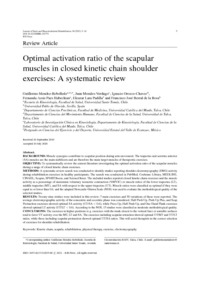Mostrar el registro sencillo de la publicación
Optimal activation ratio of the scapular muscles in closed kinetic chain shoulder exercises: A systematic review
| dc.contributor.author | Méndez-Rebolledo, Guillermo | |
| dc.contributor.author | Morales-Verdugo, Juan | |
| dc.contributor.author | Orozco-Chavez, Ignacio | |
| dc.contributor.author | Habechian-Zamuner, Fernanda A. | |
| dc.contributor.author | Lara Padilla, Eleazar | |
| dc.contributor.author | Berral de la Rosa, Francisco J. | |
| dc.date.accessioned | 2021-11-22T17:31:18Z | |
| dc.date.available | 2021-11-22T17:31:18Z | |
| dc.date.issued | 2021 | |
| dc.identifier.uri | http://repositorio.ucm.cl/handle/ucm/3497 | |
| dc.description.abstract | BACKGROUND: Muscle synergies contribute to scapular position during arm movement. The trapezius and serratus anterior (SA) muscles are the main stabilizers and are therefore the main target muscles of therapeutic exercises. OBJECTIVE: To systematically review the current literature investigating the optimal activation ratio of the scapular muscles during a range of closed kinetic chain exercises. METHODS: A systematic review search was conducted to identify studies reporting shoulder electromyography (EMG) activity during rehabilitation exercises in healthy participants. The search was conducted in PubMed, Cochrane Library, MEDLINE, CINAHL, Scopus, SPORTDiscus, and ScienceDirect. The included studies reported closed kinetic chain exercises and the muscle activity as a percentage of maximum voluntary isometric contraction (%MVIC) or muscle ratios of the lower trapezius (LT), middle trapezius (MT), and SA with respect to the upper trapezius (UT). Muscle ratios were classified as optimal if they were equal to or lower than 0.6, and the adapted Newcastle-Ottawa Scale (NOS) was used to evaluate the methodological quality of the selected studies. RESULTS: Twenty-nine studies were included in this review; 7 main exercises and 30 variations of these were reported. The average electromyographic activity of the concentric and eccentric phase was considered. Half Push Up, Push Up Plus, and Scap Protraction exercises showed optimal SA activity (UT/SA < 0.6), while Press Up, Half Push Up, and One Hand Plank exercises showed optimal LT activity (UT/LT < 0.6). According to the NOS, 15 studies were classified as moderate methodological quality. CONCLUSIONS: The exercises in higher positions (e.g. exercises with the trunk closest to the vertical line) or unstable surfaces tend to favor UT activity over the MT, LT and SA. The exercises including scapular retraction showed optimal UT/MT and UT/LT ratios, while those including scapular protraction showed optimal UT/SA ratios. This will assist therapists in the correct selection of exercises for shoulder rehabilitation. | es_CL |
| dc.language.iso | en | es_CL |
| dc.rights | Atribución-NoComercial-SinDerivadas 3.0 Chile | * |
| dc.rights.uri | http://creativecommons.org/licenses/by-nc-nd/3.0/cl/ | * |
| dc.source | Journal of Back and Musculoskeletal Rehabilitation, 34(1), 3-16 | es_CL |
| dc.subject | Kinetic chain | es_CL |
| dc.subject | Scapula | es_CL |
| dc.subject | Rehabilitation | es_CL |
| dc.subject | Physical therapy | es_CL |
| dc.subject | Exercise | es_CL |
| dc.subject | Electromyography | es_CL |
| dc.title | Optimal activation ratio of the scapular muscles in closed kinetic chain shoulder exercises: A systematic review | es_CL |
| dc.type | Article | es_CL |
| dc.ucm.facultad | Facultad de Ciencias de la Salud | es_CL |
| dc.ucm.indexacion | Scopus | es_CL |
| dc.ucm.indexacion | Isi | es_CL |
| dc.ucm.doi | doi.org/10.3233/BMR-191771 | es_CL |



